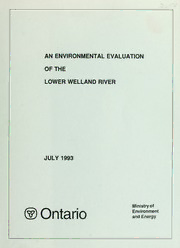
An environmental evaluation of the lower Welland River PDF
Preview An environmental evaluation of the lower Welland River
AN ENVIRONMENTAL EVALUATION OF THE LOWER WELLAND RIVER JULY 1993 @ Ministryof Ontario Environment andEnergy ISBN0-7778-1644-X ANENVIRONMENTALEVALUATION OFTHELOWERWELLANDRIVER JULY 1993 Cettepublicationtechnique n'estdisponiblequ'enanglais. Copyright: Queen'sPrinterforOntario, 1993 Thispublicationmaybereproduced fornon-commercialpurposes withappropriateattribution. PIBS2659 ANENVIRONMENTALEVALUATION OFTHELOWERWELLANDRTVER Reportpreparedby: R.JPope, K.AKeenleyside, S.DSpeller TarandusAssociatesLimited for TheNiagaraRiverImprovementProject OntarioMinistryoftheEnvironment JULY 1993 DISCLAIMER The content and conclusions ofthis report do not necessarily reflect the views and policies of the OntarioMinistryofEnvironmentandEnergy. The dataaspresented areregarded asvalid and canbe usedinadditionalassessments. Mention of trade names or commercial products doesnotconstituteendorsementorrecommendation foruse. ExecutiveSummary An environmental evaluation of the lower Welland River was conducted by Tarandus Associates Limitedduringthesummerandfallof1990. Thestudy involvedanassessmentofwaterandsediment quality, as wellas an examinationofaquatic floraand fauna. Theobjectivesofthestudy were: 1) to obtain a database subset forthe lowerWelland River foruse in assessing possibleremediation options whereappropriateand fordetermining the need forfurtherenvironmental investigationsand; 2) to provide information for use in evaluating the significance oftheWelland River regarding environmental quality issues in the Niagara River Area of Concern. Afteraninitialreconnaissanceofthestudyarea, fieldtripstothelowerWellandRiverwerecompleted during Augustand November, 1990. A total of25 stationswereevaluated. Analysesofsediments and water from these stationswereconducted by Beak Analytical Laboratories. Waterqualityvariedconsiderablyamongstations. Atseveral sites, iron, copper, mercury, andtotal phosphorus exceeded the Provincial Water Quality Objectives (PWQO). Most water-quality parameters,however,includingmostmetals,phenols,totalcyanide,PCBs,polyaromatichydrocarbons (PAHs), and organochlorine (OC) pesticides were below detection limits. Data from regular MOE water-quality monitoring stations indicate that levels of zinc, copper, mercury, chromium, and lead have decreased in the Welland River from 1979 to 1987. A slight increase in aluminumconcentrations in water, however, has been noted from 1981 to 1987. Sediment quality was also variable throughout the study area. Concentrations oflead, chromium, mercury, cadmium, zinc, iron, nickel,copper, arsenic, total Kjeldahlnitrogen, totalorganiccarbon, totalphosphorus,andPCBsexceededtheMOEProvincialSedimentQualityGuidelines(PSQG)lower effectlimit(LEL)atsomestations." ThePSQG-SevereEffectLimits(SEL)forchromium, mercury, nickel, iron, andcopper werealsoexceededatseveral stationsin sections Band Cofthestudyarea. Concentrations of total cyanide and oil and grease exceeded the Open Water Disposal Guidelines (OWDG) atsomestations. PAHswerealsodetectedatseveral stations, mostnotably stations9and 10. All organochlorinepesticides were below detection limits. Degraded sediment quality, as indicated by concentrations of several metals, oil and grease, total cyanide,andPAHswere foundatstations9, 10,24, 11, and 12, in thelowerWellandRiverbetween thesyphons, as wellasatstations 17, 18, 19and20in thesectioneastofPortRobinson. Sediments atstation 7, located in thewestern portion oftheCityofWellandalso hadelevatedconcentrationsof several contaminants. A numberofcontaminant inputs are located in the vicinity ofthese stations, includingstormsewers,alandfillsite,awaterpollutioncontrolplant(WPCP),andseveralindustries. Ninetybenthic-invertebratetaxawereidentifiedatthe25 samplingstations. Thetotal issignificantly higher than the 28 taxa reported previously (Johnson, 1964). The number of taxa varied among stations, rajiging from alow of 12 speciesat stations 6and25 toa high of29 speciesatstation 10. Two invertebrate species were common to all the sampling stations; Procladius sp. and immature tubificids,althoughChryptochironomussp.,Limnodrilushoffmeisteri, andSphaeriumsp. werefound at24ofthe25 sites. Johnson (1964)also noted ProcladiusandLimnodrilusthroughouttheWelland River. Sampling stations located upstream ofthe City ofWelland were characterized by relatively high numbers of Hexagenia sp. and Coelotanyus sp. These species were generally absent from stationsdownstreamofWelland,indicatingdegradedenvironmentalconditions. Stationslocatedbelow theurbanizedareaswerecharacterizedbyrelativelyhighnumbersofthemorepollution-toleranttaxa, Spirospermaferoxand immaturetubificids, as wellas Valvatasp., andHydrobiidae. Thetotalabundanceofbenthicinvertebratesvariedamongstationsinthestudyarea, andranged from alowof634individualspersquare meteratstation 12 toahighof5900individualspersquaremeter at station 22. Generally, stations located in and below the City of Welland had higher total abundances than those located in the rural areaaboveWelland. Benthic-invertebratediversity (Shannon-Weaverand Brillouin) fluctuated considerably, especially in the river below the City of Welland. Diversities at all the stations upstream of Welland were relatively constant, ranging from 3.02 to 3.53. Shannon diversities ranged from a high of3.96at station 11 toalowof2.52atstation25. SimilartrendswerenotedwiththeBrillouindiversityindex. Diversities greater than 3.0are generally indicativeofunpollutedconditions. Discriminantanalysis ofthe stations, based on the results ofclusteranalyses, indicated thatbenthic- invertebratecommunitiesbelow theCityofWellandandabovetheQueenston-ChippawaCanalwere associated with sediments characterized by elevated concentrations of several metals including chromium, copper, and arsenic. In contrast, benthic communities at stations above the City of Welland, occurred in an areacharacterized by sediments havingrelatively lowlevelsofmetals, and ahighlossonignition. AluminumwasalsofoundathigherconcentrationsinthispartoftheWelland Riverthan at stations furtherdownstream. The fish community of the lower Welland River was dominated by warmwater species, including catfish, whitecrappie, carp, suckers, and freshwaterdrum. Salmonid species were notfoundin the lowerWelland River, although they arecommon in the Niagara River. The Welland River shoreline was dominated by several emergent aquatic macrophytes, including TyphalatifoUaandSagiitarialaiifolia. A numberofsubmergedaquaticmacrophyteswerealsonoted including Myriophyllum spicamm, Vallisneria americana, and Ceratophyllum demersum. These specieshavebeenpreviouslyreported inthestudyareabyJohnson (1964)andDickmanetal. (1983). Previous authors have also noted areas devoid of higher aquatic plants below several industrial discharges (Dickmanand Haynes, dateunknown; Dickman eral, 1983). During this study, sparse macrophytegrowth was only noted below theThompson'sCreekconfluence.
